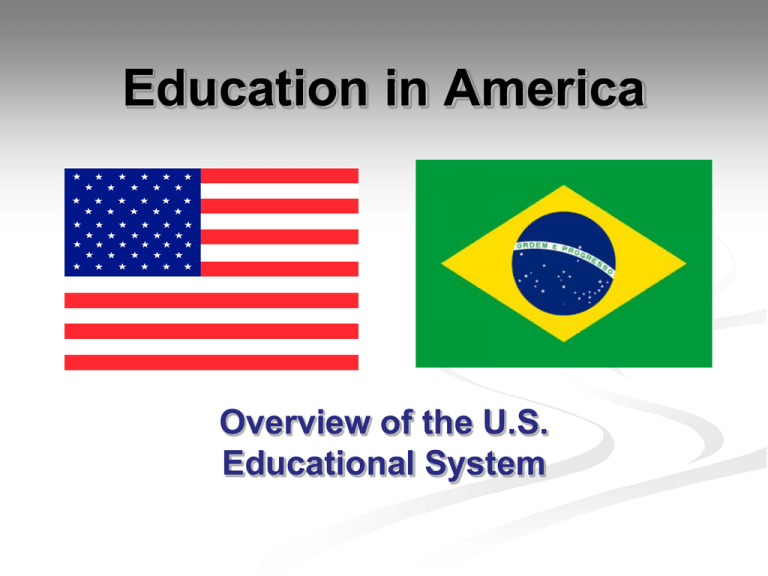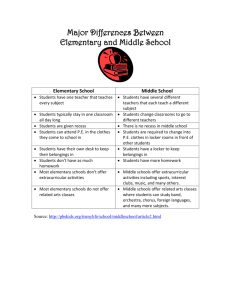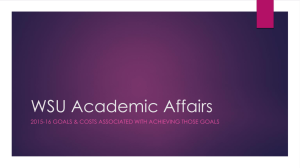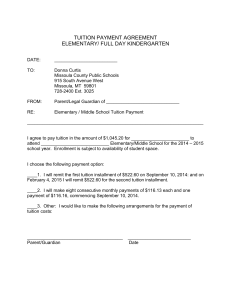Education in America Overview of the US Educational System
advertisement

Education in America Overview of the U.S. Educational System Overview Topics Overview of the U.S. Educational System: o The roles of federal, state and local government: o Financing of education (who is responsible for what) o Numbers (students, teachers in the school system) o school calendar o Types of school (public, private, charter, religious, other) o Grades/ages o Community involvement in education o Certification for administrators, teachers o Training opportunities o Student Assessment Federal, State and Local Government U.S. Department of Education - federal regulations related to Title Mandates – tied to funding (3 – 5% of school budgets): • Equal rights for women – Title IX • Support for at-risk children and families – Title I • IDEA – 504 and Special Education State Education Agency– Constitutional right for states to regulate education – funding coordination to school districts (95% of budget to dist) • State Commissioner appointed by governor • Elected state board of education oversees state curriculum, testing requirements, personnel regulations (retirement) Local District – Elected school boards of 7 – 9 members • Hire/evaluate the superintendent • Budget oversight – distribution of funds to schools, salary schedules for employees, etc. The politics and economics of education in the U.S. Political debate “No Child Left Behind” – data driven environment School choice Private school vouchers Sources of funding Federal State Local school district Private funds Schools receive a combination of funds Funding may be de-centralized AMERICAN EDUCATIONAL SYSTEM Doctoral Degree (3-6 years) Ph.D. PostSecondary School Master's Degree (2-3 years) Community College (2 mo. - 2 years) 17 16 15 14 13 12 11 10 9 8 7 6 5 4 3 AGE Graduate School College/University (4 years) Undergraduate Degree B.A., B.S. High School (4 years) Secondary School Middle School (Junior High) (3 years) Elementary School (5 years) Primary School 12 11 10 9 8 7 6 5 4 3 2 1 Preschool/Kindergarten GRADE Side-by side Comparison School Choice in America Public vs. Private Education Do you know how these education options differ? Public schools Charter schools (state or district) Magnet schools (district schools of choice) Private schools (religious, for profit, non-profit) Compulsory education (Kinder or 1st to graduation) High school diploma vs. G.E.D. Home school 49.5 million public school students and 3.1 million teachers Approximately 6 million students in private (ies) Alternative forms of Education Virtual School – popular in rural areas, high school credit recovery and students who need more flexible schedules Home schooling In 2007, approximately 1.5 million children were home schooled: 2.9% of all children. Often associated with religious groups. Private Schools/Private Academies Funded solely by student tuition. May offer more specialized courses or special needs. Parochial School Run by church organizations. Funded by student tuition and petitioner contributions. Charter School Funded by both private funds and public funds. Stricter control over enrollment (entry and continued) Educator Credentialing and hiring Teachers Bachelor’s Degree (4 yr) plus state exam for grade level or content level. Additional certifications may be added by coursework and exam in Special Education, English as a Second Language, Gifted and Talented, Bilingual, etc. Depending on the state, may be unionized to advocate for benefits and salaries Usually hired by principal and/or committee of school stakeholders Appraisals of performance based on student achievement Usually one year contracts Some states offer tenure to highly effective teachers Retirement benefits vary by state Not paid during summer Administrators Principals require teacher credential PLUS minimum 3 years experience as a teacher, master’s degree, state exam Depending on the state, may be unionized to advocate for benefits and salaries Usually hired by superintendent and/or committee of school stakeholders Appraisals of performance based on student achievement, surveys, discipline referrals Usually one year contracts Superintendents may require teacher credential PLUS principal credentials PLUS superintendent exam Not unionized Usually hired by local school board of trustees Appraisals of performance based on district data, budget and community satisfaction Usually 1 to 3 year contracts – characteristically high turnover rates Professional Development Training opportunities provided by the school district during the day or afterschool Many offered on-line to be completed during teacher planning time or afterschool Early dismissal days throughout the year for PD and/or parent conferences Graduate degrees pursued and paid for by teacher – not subsidized National teacher certification - http://www.nbpts.org/ National principal certification – pilot discontinued American Primary/Elementary Schools • Public Elementary School teachers instruct between 20-30 students of diverse learning needs. • A typical classroom will include children with a range of learning needs or abilities, from those identified as having special needs (special education) to students non-native English speakers (ESL students). • Each local school district provides textbooks to give to the students for each subject, and brief overviews of what the teacher are expected to teach. • Learning standards are identified for all areas of a curriculum by individual States, including those for mathematics, social studies, science, physical development, the fine arts, and reading. • Elementary School teachers are trained with emphases on human cognitive and psychological development and the principles of curriculum development and instruction. • Teachers typically earn either a Bachelors or Masters Degree in Early Childhood and Elementary Education. • Certification standards for teachers are determined by individual states. Typical Day of an American Elementary School Teacher A typical teacher works 8 hours, 5 days a week, at the same school. [August/September-June] Federal Holidays and summer vacations off from work. Primary school teachers may teach the same group of students (20-30 students) for the full day or the campus may be departmentalized – usually at testing grades (3rd and up) Courses include: Reading, Writing, Mathematics, Science, Social Studies. Teachers have one (40-45 minute) planning period during the day. Students receive classes from a different teacher—Music, Art, Gym (sports), Drama, Chorus, etc. during the teacher’s planning period Teachers meet weekly during the day to discuss students and curriculum called Professional Learning Communities (PLCs) Teachers must have one lunch break (30 minute) during the day. Many teachers stay after school to participate in extracurricular activities for students or provide additional teaching time. American Secondary Schools: Middle School Middle School include the 6th – 8th grades between elementary school and senior high school. At this time, students are given more independence: Having different teachers for each subjects. Taking on more independent homework assignments and projects. Moving to different classrooms for different subjects being allowed to choose some of their class subjects (electives). American Secondary Schools: High School High school - 9th through 12th grade. The students in these grades are classified as: Freshmen (grade 9) Sophomores (grade 10) Juniors (grade 11) Seniors (grade 12) Students are encouraged to pursue a concentration in a specific area of study in preparation for college Early college options allow students to earn college credits simultaneously Vocational programs provide certifications for graduation High School Curriculum Students take a broad variety of classes Curricula vary widely in quality and rigidity Some states consider 65 (on a 100-point scale) a passing grade, while others consider it to be as low as 60 or as high as 75. Varied tracks to graduation include Advanced Placement (AP) courses which result in graduation plans with higher GPAs End of Course exams required to earn credit toward graduation Mandatory subjects are required in nearly all U.S. high schools: Science (3 years of biology, chemistry and physics) Mathematics (4 years of algebra, geometry, pre-calculus, statistics, and calculus) English (4 years of literature, humanities, composition, etc.) Social sciences (3 years world and U.S. history, gov./economics) Physical education (4 years) Many states require a "health" course (anatomy, first aid, sexuality, birth control) Extracurricular Activities in American Schools A major characteristic of American schools is the high priority given to sports, clubs and activities Extracurricular activities are educational activities not falling within the scope of the regular curriculum but under the supervision of the school. These activities can extend to large amounts of time outside the normal school day and include: Sports Programs—Football, Basketball, Soccer, Swimming, Wrestling, Cheerleading, Rowing, Dance, etc. Performing Arts—orchestra bands, jazz bands, marching bands, choirs, school plays/drama clubs/musicals Debate teams, Student Government, Public Awareness Organizations, Various Clubs (Poetry Club, Photography Club, etc.) Language clubs (primarily Spanish and French clubs) Cultural activities Many parents pay for lessons and activities to supplement their children’s edcuation. Social Issues in American Education English Acquisition Debate on how to best accommodate for non-English speaking students and parent interest in foreign language instruction. ESL programs vs. Bilingual programs Dual Language Programs Common Core - Nationwide Education Content and Education Quality Different content, grade systems and quality Textbook Review and Adoption Other Issues Education regarding violence, sex and drug abuse GLBTQ – Social issues and integration Support students who are working Common Core States Post-secondary Education Options Public/private universities and colleges Community colleges and vocational schools Rising Cost of Tuition for higher education/school loans Cost of Higher Education CNN/Money reported tuition hikes in 2004/05 Student Assessment • • • • • Cost to taxpayers – Big business as states out-source testing administration/scoring to private companies Preparation for the test diminishes students and teachers as people Need for accountability and equity Tremendous stress in children contributing to mental health issues Educators leaving the profession Community Involvement in Education • • • • • Parent-Teacher Association (PTA) or Parent-Teacher Organization (PTO) Site-based Decision-Making Committee (SDMC) Booster Clubs Fundraising – festivals, raffles, sales School Boards elected to oversee district schools Garden Oaks Montessori • • • • • • • • Pre-Kindergarten (3 yr olds to 8th grade) 780 students 7:45am – 3:00pm (extended day 7:15am to 6pm) Free breakfast and dinner Sliding scale lunch Welcoming Schools campus of Excellence National Magnet School of Distinction Robotics, library, music, physical education, computer lab, science lab, gardens • Video of MSAP grant work Thank you! Lindsey Pollock, Ed. D. Garden Oaks Montessori, Houston Independent School District lpollock@houstonisd.org (713) 822-2274


![Educational Setting – Offer of FAPE [IEP7B] English](http://s3.studylib.net/store/data/006809815_1-704b6bcef8e9a29f73a2206ea1b6ed19-300x300.png)



